
Tribes of Africa
Throughout various parts of the large and diverse continent that is Africa, there exist tribes that have shown the ability to preserve their unique traditions and cultures.
These attributes, though once a source for discrimination are now being viewed as a valuable resource in to learning how life was lived in the past.
Some African tribes such as the Dogon have shown that their ancestors were able to accurately read extra solar astronomical entities, while tribes such as the Hadza have through oral tradition been able to depict human prehistory, much like modern scientists have been able to.
The various handicrafts, jewelry, hairstyles, body and cave arts are also just some of the remarkable achievements that add the world's artistic value.
Although there are thousands of tribes spread out across the beautiful continent that is Africa, the following are only 15 of the most interesting African tribes that we have been able to locate and analyze.
1. Ashanti

The Ashanti tribe or Asante are located in the Ashanti Region of today's modern country of Ghana, and their population is estimated at about 3,000,000. They speak the Asante dialect of the Twi language.
The word Asante is believed to mean both "warlike" and "because of wars".
Their society is a matrilineal one, in which the line of a person's descent is traced through the female and historically, the progeny and the mother's relationship determined titles, inheritance of property, land rights and official posts.
The Ashanti people are blessed with natural resources that have made them quite wealthy.
They formed the Ashanti Empire along the Gulf of Guinea and Lake Volta, a land endowed with vast deposits of industrial minerals, most noteworthy being the huge deposits of gold.
In the years 1823 through to 1896, the Ashantis were very much feared by the colonial British government.
They were described as a capable, fierce and organized people whose leaders can summon over 200,000 soldiers into the battlefield.
After four wars, the British would finally defeat the Ashanti king in 1901.
Most notable of their culture and traditions are their beautifully designed Ashanti Kente clothing, and the intriguing sounds of their Fontomfrom drums and Seperewa or 10-14 stringed harp/lute.

Twentieth Century Ashanti Akrafena (Sword with Golden handle)

An Asante Gold Plated Shield
2. Berber
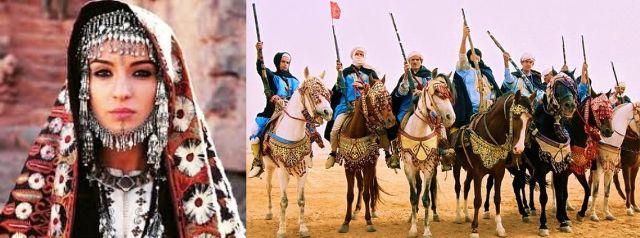
The Berber tribe or Amazighs are located mostly in North Africa, namely in Algeria, northern Mali, Morocco, Mauritania, northern Niger, Libya, Tunisia, and a part of the western part of Egypt.
The name Amazighs is believed to mean "free people" or "noble men", while the name Berber comes from the Egyptian term for "outlander".
Currently, there are an estimated 25-30 million Berber language speakers in North Africa, with a large majority of them adhering to the Muslim faith.
The general term used to describe all the different Berber languages is Tamazight and the areas in North Africa that have best been able to preserve the languages and traditions are in Morocco, parts of Algeria (Hautes Plaines).
The region called Maghreb in northwestern Africa is thought to have been inhabited by Berbers from as late as 10,000 B.C. Cave paintings dating to the twelfth millennia were found in regions of southern Algeria.
In ancient times, the Berbers followed the Berber religion which gave priority to ancestor veneration, animism, and polytheism. These beliefs still exist in modern times albeit through popular culture and tradition.
Westerners often label the Berbers as nomads, but in fact most were traditionally farmers, residing in mountainous regions close to the Mediterranean coast or living by oases. Only the Tuareg and Zenaga of the southern Sahara are the true nomadic tribes.
Islam and its penetration among the Berbers did not guarantee the support for the Arab dominated caliphate. This was largely due to the discrimination posed by the Arabs on the Berbers, through alienation, heavy taxation, enslavement, etc.
This would result in widespread opposition which inevitably led to open revolt.
Even today, there are activists that believe that the issue of the persecuted Berbers by Arabs is long past overdue to begin facing the Arabization through discrimination of the Amazigh lands.
Some of the Berber's traditions include weaving kilims, in which the tapestry maintains the appearance and distinctiveness of the region of origin of each tribe which also flows into their drawings.
The textile of plain weave is portrayed by a wide assortment of stripes, and more infrequently by geometrical patterns such as triangles and diamonds.

Berber Hand Art
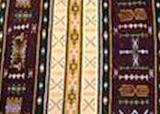
Berber Traditional Rug

Berber Traditional Jewelry
3. Hamer
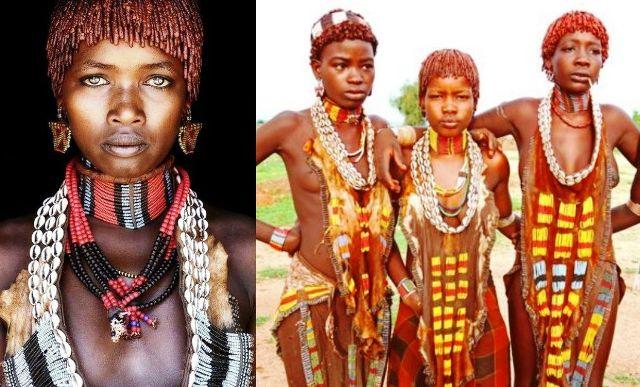
The Hamer tribe or Hamar are located in the southwestern part of Ethiopia in the fertile area of the Omo River valley.
Their population is estimated at about 50,000, with only about 10,000 residing in urban areas.
The Hamers are pastoralists and place a high value on cattle.
One of their unique customs includes "bull jumping", in which a boy is made into a man.
It is a 3 day rite of passage that all males must participate in, and it is extremely important for the pride of both the initiate and his family.
The boy must walk over fifteen castrated bulls that have been rubbed in cow dung to make their backs slippery.
If he fails, the initiate has to wait a year to attempt it again. By succeeding the boy is ready to marry a girl his parents choose for him, and later to raise his own children and cattle.
4. San

The San or Saan tribe, also called Bushmen is located in Botswana, Angola, Namibia, Zambia, Lesotho, and Zimbabwe.
The language of the San is Khoesan and their population is believed to be in the range of 50,000-60,000 in Botswana alone.
They are primarily indigenous hunter-gatherers, who are believed to have been the first inhabitants of what is today South Africa and Botswana.
In some areas of northern Botswana, stone tools and rock art dating back over 70,000 years is said to be of San origin. The rock art is the oldest "art work" ever to have been discovered.
In popular culture, the San have been extensively used in books, movies, etc. The Gods Must Be Crazy was an international hit movie about the Kalahari San group's first encounter with an item from outside their own secluded world.
5. Zulu

The Zulu tribe or amaZulu ar located in the southern part of Africa, mainly in South Africa, with a few in Zimbabwe, Zambia, Mozambique, and Tanzania.
The total population of the Zulu is estimated at about 12,000,000 and they are the largest tribe in South Africa.
They are of the Bantu ethnic group and their language is known as isiZulu or kwaZulu. The name Zulu is said to mean "weather" or "heaven" in the Nguni language.
Most notable in their history is the formation of an all powerful state called the Mthethwa Empire in 1818 under the great Zulu King Shaka.
By 1979, the then King of the Zulus, Cetshwayo would refuse to bow down to British colonial efforts and win decisive victories before being defeated.
The original Zulu religion held that ancestor spirits known as the amaThongo or amaDlozi had the power to affect people's lives for the better or the worse. They believe that there are three elements that are attributed to a human, the physical body or "umzimba", the life force or "umoya" and the personality or "isithunzi".
Once the spirit leaves the body, one may continue to live as an ancestral spirit only if they led a life of "ubuntu", or showing respect and generosity towards others.
Today the Zulu are evenly spread out in urban and rural areas, but the KwaZulu-Natal is considered their heartland in the relatively prosperous Gauteng province.
6. Tutsi

The Tutsi tribe or Abatutsi are located in the African Great Lakes region, primarily in the countries of Rwanda and Burundi, but they are also present in the Democratic Republic of Congo, Uganda, and Tanzania.
Their language is known as Rwanda-Rundi and is a Bantu subgroup of the Niger-Congo family.
The Tutsi and Hutu (largest tribe in Rwanda) have had their definitions change throughout time and location, making them difficult to separate and classify.
To create an easier form of colonial rule, the Belgians would define Tutsi as anyone owning more than 10 cows (wealthy) or by simply having a longer nose or longer neck.
Traditionally, the Tutsis were ruled by a holy king, who administered justice and government.
They were also the only ones allowed to own cattle to sustain themselves. This gave them ample free time, allowing them to create a rich culture of music, weaving, and poetry.
Tutsi burial traditions are closely related to the Cushitic Sidama peoples in the Gibe region of southern Ethiopia, hinting at a connection between these two peoples.
7. Ndebele
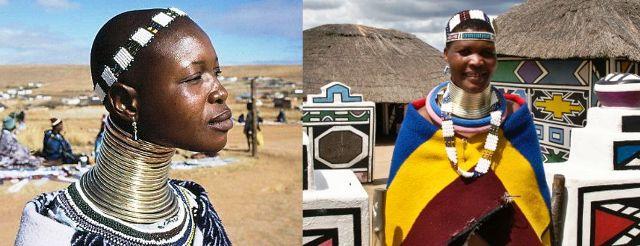
The Ndebele are made up of two different tribes of people sharing the same name: the Southern African Ndebele and the Northern African Ndebele. For purposes of this article, we shall be focusing on the Southern Ndebele tribe.
The Southern African Ndebele are of the Nguni ethnic group located in the northeast region of South Africa, namely Limpopo, Gauteng and Mpumalanga provinces.
Their population is about 1.1 million and their language is the Southern Ndebele or isiNdebele seSewula.
This tribe shares many similarities to their Zulu neighbors, when it comes to authority and political structures.
Unique traditions attributed to the Southern Ndebele include the copper and brass rings (idzila) that married woman wear on their arms, neck and leg to show their love and faithfulness for their husband.
Southern Ndebele arts and crafts play an important role in the culture of the people, for example, the women would paint intricate and colorful patterns on the walls of their house to show her individuality and self-importance.
The more unique her design the more she reaffirms her individuality and talent.
8. Wodaabe

The Wodaabe tribe also known as the Bororo and Mbororo are a historically nomadic cattle traders and herders located in the Sahel and spreading out through from southern Niger, northeastern Cameroon, southwestern Chad, northern Nigeria, and western Central African Republic.
Their population is estimated to be around 45,000-100,000 and their language is called Fula.
Interestingly enough, the Fula language uses no written form and the meaning of Wodaabe is literally translated to "people of the taboo" or "those who respect taboos".
This indicates the Wodaabe's inclination to follow more ancient cultural and traditional elements of life and their rejection of integration with their neighbors.
The rules of behavior that govern Wodaabe society include "semteende" or modesty, "munyal" or patience, "hakkilo" or forethought, and "amana" or loyalty.
The Wodaabe tribe also places great importance on charm and beauty, this is portrayed in the In-Gall's Cure Salee salt market and Tuareg seasonal festivals.
During these festivals young male suitors in make-up, feathers and other accessories will perform the "Yaake" dance and song to show off their talent and beauty.
White eyes and teeth, as well as being tall are characteristics most appreciated by the tribe.
9. Maasai
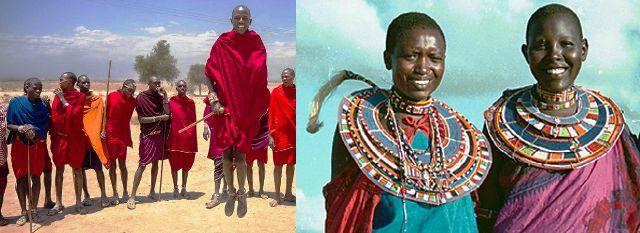
The Maasai tribe is of the Nilotic ethnic group located in the southern and central parts of Kenya, as well as, in the northern parts of Tanzania.
Their population is in the range of 1.7 million and they speak the Maa language, which is related to the Dinka and Nuer languages.
The traditional diet of the Maasai tribe consists of raw meat, raw milk and raw blood from cattle.
The Maasai are said to be one of the tallest people in the world, with an average height in the range six foot and three inches.
They are widely feared and respected for their reputations as cattle rustlers and warriors.
By the mid 19th century, the Maasai had rule over almost all of the Great Rift Valley after forcibly evicting other settlers through the use of their spears, shields and the most feared "throwing clubs" or "orinka".
Unfortunately, the years 1883-1902 known as the Maasai Emutai, was a time of great distress as diseases ravaged the cattle and human population.
Starvation due to losing 90% of their cattle, droughts, and small pox reduced the once great Maasai numbers to less than two-thirds.
A traditional rite of manhood of the Maasai was to have a yet to be circumcised young man kill a lion but this rite is now one of the past.
A unique coming of age ceremony for warriors of the Maasai, is a 10 or more day singing and dancing ritual called the Eunoto.
Warriors march past and do the jumping dance or "adumu", which consists of one or two men at a time entering the center to jump while maintaining a narrow posture, and never allowing the heels of their of feet touch the ground.
Girls and mothers also take part in this ritual by parading spectacular costumes, singing and dancing.
10. Pygmies
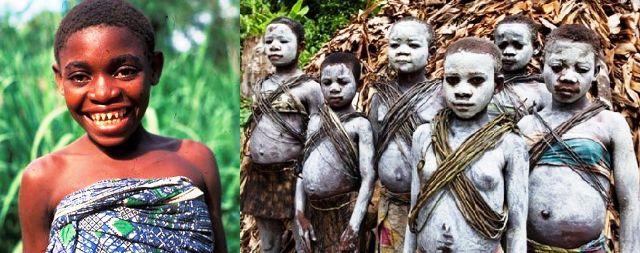
Pygmies or the Pygmy tribe are mainly located in central Africa and are historically known to be hunter-gatherers living in the rainforests.
The various Pygmy groups such as the Twa, Aka, Mbuti, and Baka have their own languages, traditions, and hunting techniques and reside in countries such as Cameroon, Rwanda, Uganda, Central African Republic and the Democratic Republic of Congo.
The population of the Pygmies is estimated to be at about 500,000.
The word "Pygmy" is often associated with a negative meaning but has more recently been accepted as a term of identity by the various Pygmy groups.
Mostly though, they identify themselves as the "forest people" because of the deep value they hold for nature and the forest.
Pygmies love the forest as they love their own bodies.
"Jengi" or the spirit of the forest is one of the few words or belief that almost all groups of Pygmies share in common.
Recently, the Pygmies are in danger because of discrimination and the many threats and challenges they are facing from outsiders.
Logging, national parks, war, rape, slavery, and murder are just a few of the problems being felt by the Pygmies today.
Even their usually healthy diet traditionally attained from the forest is no longer available to them, and they are now severely malnourished and suffering.
11. Himba

The Himba tribe or OmuHimba are located in the northern part of Namibia and near the Kunene River in Angola.
Their populations are estimated to be around 50,000 and they are considered to be the last semi-nomadic people of Namibia.
The women and girls of the Himba do more labor intensive work such as home building, carrying water, collecting firewood, milking livestock, cooking, making handicrafts, clothing, and jewelry.
The men on the other hand only tend to livestock, farm, hold council, slaughter, and do some construction work.
The Himba women make incense which is used as an antimicrobial body cleanser, deodorant, and as a perfume of sorts.
The men are well known for their "otjize" paste, which is made from butterfat and ochre. Due to the scarcity of water, it is used to keep their bodies clean and to protect them from mosquito bites.
Unique to the Himba is their traditional usage of jewelry and hairstyles, which is important in their society as a means of showing age and social status.
Due to the unforgiving desert climate of their region, they have been able to live in relative seclusion and this has helped them retain many of their traditional ways of life.
The Himba worship the "Mukuru" god as well as their ancestor's spirirts and are known to practice "omitti" which some call witchcraft or black magic.
12. Mursi
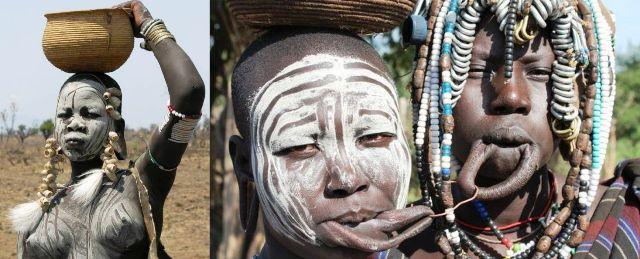
The Mursi tribe or Mun as they call themselves are a primarily pastoral group that is of the Nilotic ethnic group in Ethiopia.
They are located in the Southern Omo Region in southern part of Ethiopia, close to the border with neighboring South Sudan.
The Mursi population is estimated to be around 7,500 and their land is considered very secluded due to the surrounding mountains and the Omo and Mago Rivers cutting them off from outsiders.
A unique tradition of the Mursi lies in their various rites of passage, such as the famous lip plates they are known for.
They are one of the last groups of people in Africa that still wear large wooden discs and pottery in their lower lips.
The Mursi girls are pierced at the ages of 15 and 16 to which they will wear these adornments during a dance of the unmarried women.
Another tradition unique to the Mursi, is the ritualized violence by male members of the tribe which is considered a very popular and culturally valued activity.
13. Dogon

The Dogon tribe is located in western Africa in the countries of Mali, Niger, and Burkina Faso.
Their population is estimated at about 400,000 to 800,000 and they speak the self named Dogon language.
Dogons are known for their religious sculptures which they keep hidden due to its symbolic meaning and the process through which it was made.
Aside from the intricately designed masks that the Dogon wear for ceremonies, other attributes of their religion single them out as unique.
It has been asserted that the Dogon's traditional religious beliefs include details about extra solar astronomical bodies that could not have been seen with the naked eye.
This has led to the New Age and ancient astronaut believers to claim that this is indeed evidence that extraterrestrial entities had visited Mali and in turn the Dogon tribe in the past.
Research that says the Dogon knew about the rings of Saturn and the moons of Jupiter lend credence to this belief.
14. Hadza

The Hadza tribe or Hadzabe are located in north-central Tanzania and their population is estimated at about 1,200-1,300.
They are genetically not closely related to any other people and their Hadza language which as clicks in it, appears to be unrelated to any other known language.
The Hadza until the last hundred years, have been able to maintain their way of life and territory for thousands of years with little to no change.
Notably, as one of the world's oldest ethnicity still existing, their oral history is almost identical to what modern science states about humanity's prehistory, namely Australopithecines, Homo erectus, and Archaic Homo sapiens.
15. Afar

The Afar tribe also known as the Odali, Adali, ad Danakil people are located in the Horn of Africa, mainly in the Afar region of Ethiopia, southern Eritrea, and northern Djibouti.
Their population is estimated at about 8,000,000 and they are associated with the powerful and prosperous medieval Adal Sultanate which controlled a large part of the northern area of the Horn of Africa.
